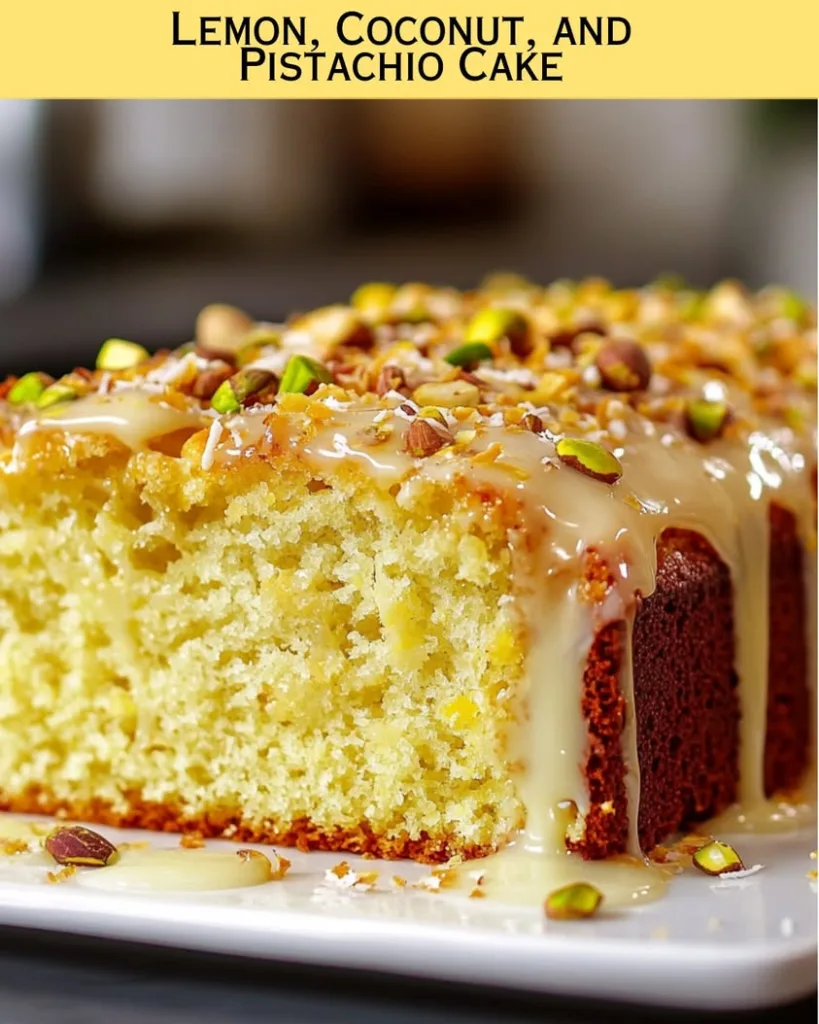Lemon, Coconut, and Pistachio Cake: A Zesty Delight for Any Occasion
Lemon, Coconut, and Pistachio Cake is not just a dessert; it’s an experience that will tantalize your taste buds and fill your kitchen with the most delightful aromas. The bright zing of lemon blends beautifully with the tropical sweetness of coconut, while the crunch of pistachios provides a delightful contrast. Every bite not only brings a burst of flavor but also a heartwarming feeling reminiscent of childhood baking days, making it perfect for gathering with loved ones or even a quiet evening at home.
This cake is a true showstopper, combining simple yet elegant flavors that shine through. The moist and fluffy texture, infused with lemon zest and coconut, creates a delightful treat that’s as pleasing to the eye as it is to the palate. Topped with a sprinkle of crushed pistachios, this cake makes an excellent centerpiece for birthdays, holidays, or any celebration that calls for something truly special.
Quick Recipe Highlights
- Flavor Profile: The blend of zesty lemon, creamy coconut, and nutty pistachio creates a harmonious taste that’s both refreshing and indulgent.
- Texture: This cake presents a delightful balance of moistness from the coconut, fluffiness from the whipped eggs, and the satisfying crispness of the pistachios.
- Aroma: The fragrance of freshly zested lemons mingles with the heavenly scent of toasting coconut, creating an inviting aroma that fills your home.
- Visual Appeal: With its sunny lemon frosting and green pistachio topping, the cake is a vibrant addition to any dessert table, inviting guests to indulge.
- Skill Level Needed: While slightly advanced, this recipe is approachable for anyone with basic baking skills. It provides great learning opportunities for new bakers!
- Special Equipment: A good quality cake pan, electric mixer, and zesting tool will enhance your baking experience and ensure a perfect outcome.
Recipe Overview
- Difficulty Level: This medium difficulty recipe requires attention to detail in measuring and mixing, making it a perfect challenge for enthusiastic bakers looking to build their skills.
- Category: Ideal for dessert or afternoon tea, this cake can brighten any meal or occasion, providing a sweet end note to your dining experience.
- Cuisine: This cake draws inspiration from Mediterranean influences, known for its vibrant flavors and the use of nuts and citrus, providing a fresh escape in every bite.
- Cost: Approximately $15 for ingredients, making it an affordable luxury that can serve multiple guests.
- Season: Best enjoyed in spring and summer when fresh lemons are in season, reflecting their tartness beautifully against the sweet coconut.
- Occasion: Perfect for birthdays, celebrations, or simply as a delightful treat for any day that deserves something special.
Why You’ll Love This Recipe
This Lemon, Coconut, and Pistachio Cake is undoubtedly a feast for the senses. The vibrant zestiness of lemon not only brightens the palate but also uplifts the spirit, making it an ideal treat for any day. Combined with the creamy layer of coconut, this cake offers a tropical escape, turning ordinary moments into extraordinary memories. The pistachio chunks add a rich, nutty flavor that complements the lush, smooth texture of the cake perfectly.
In addition to its flavor, its preparation is straightforward yet satisfying. This cake can be whipped up in under an hour, making it a convenient choice for sudden gatherings or last-minute celebrations. With simple ingredients that are easy to find, you’ll find joy in crafting this delicious dessert without the stress of complicated steps.
Beyond its indulgence, this cake also brings notable health benefits. Coconut is high in good fats, which not only help with nutrient absorption but also provide energy. The addition of nuts offers proteins and fiber, making this cake more wholesome than typical sugary desserts.
Socially, this cake works wonders in entertaining. Its stunning appearance is sure to impress your guests, sparking conversations and creating a warm, inviting atmosphere. Whether shared at a holiday gathering or as an afternoon coffee break treat with friends, the Lemon, Coconut, and Pistachio Cake encourages sharing and connection.
Finally, this recipe offers great value. With relatively inexpensive ingredients, the resulting cake serves up to eight people, making it a budget-friendly option for any occasion. Plus, it provides a delectable experience that feels lavish without the hefty price tag.
Historical Background and Cultural Significance
The origins of Lemon, Coconut, and Pistachio Cake can be traced back to Mediterranean culinary traditions, where the use of citrus fruits and nuts is prevalent. Historically, lemons were used to brighten flavors and preserve food, while coconut and pistachios have been cherished for their rich flavors and textures. The fusion of these ingredients in a cake showcases the harmonious balance found in Mediterranean desserts.
Culturally, this cake represents the essence of home cooking and sharing. In many households, baking is a cherished family activity, passed down through generations. The warm and inviting nature of this dessert speaks to traditions of hospitality and care, making it a beloved choice in celebrations and gatherings.
Over time, the recipe has evolved to incorporate local ingredients and preferences, resulting in numerous variations across different regions. Some may include additional spices, while others focus more on the citrus aspect, yet the heart of the cake remains unchanged: a celebration of freshness and flavor.
In different cultures, this cake may find its place on tables during festivals or important family events, symbolizing joy and togetherness. Each slice not only delivers flavor but also a narrative of love, tradition, and the joy of sharing food with those we care about.
Ingredient Deep Dive
Lemon serves as the star ingredient in this cake, bringing a refreshing zing that brightens the flavor profile. Citrus fruits have a rich history in ancient cultures, originally prized for their ability to preserve food as well as their therapeutic benefits. Nutritionally, lemons are an excellent source of vitamin C and antioxidants, which promote good health. When selecting lemons, look for ones that are firm and have a bright yellow color for the best flavor. To store, keep them at room temperature or refrigerate for long-term use.
Coconut adds a creamy sweetness that enhances the cake’s overall flavor. With roots in tropical regions, it has become widely popular around the world for its versatility. Coconuts contain medium-chain triglycerides (MCTs) that are known to boost energy levels. Choose organic, unsweetened shredded coconut for the best flavor and texture. To store, keep it in an airtight container in a cool, dry place to maintain freshness.
Pistachios lend a nutty crunch to the cake while also contributing to its vibrant aesthetic. Traditionally enjoyed as a snack in Middle Eastern cultures, they are now loved worldwide. Rich in protein, fiber, and healthy fats, pistachios support heart health and weight management. When selecting, look for unsalted, shelled options for baking. Store in a cool, dry place or refrigerate to prolong freshness.
Common Mistakes to Avoid
- Overmixing the Batter: Care should be taken not to overmix the cake batter after adding the flour, as this can result in a dense cake. Mix just until combined for a light texture.
- Incorrect Oven Temperature: Be sure to preheat your oven and use an oven thermometer to ensure that the temperature is accurate, preventing undercooked or overbaked cakes.
- Using Old Ingredients: Fresh ingredients are crucial for flavor and texture. Always check the expiration dates and use fresh eggs, butter, and baking powder.
- Not Zesting the Lemon Properly: Be careful to zest only the yellow part of the lemon; the white pith is bitter and can negatively affect the flavor of your cake.
- Ignoring Documented Measurements: Baking is a science. Follow the measurements closely to achieve the desired outcome; even slight variations can lead to unforeseen changes in texture and taste.
- Skipping the Cooling Step: Allow the cake to cool completely before frosting. If the cake is warm, the frosting can melt, ruining your presentation.
- Overlooking the Nut Topping: Ensure the pistachios are evenly distributed on top of the frosting for visual appeal and balanced flavor in every slice.
- Using the Wrong Pan Size: Different pan sizes can lead to variations in baking time. Ensure you’re using the specified size to achieve the intended result.
- Frosting Too Early: Wait for the cake to cool completely before frosting to prevent the frosting from melting and losing its shape.
- Not Serving at the Right Temperature: This cake is best enjoyed at room temperature. If chilled, let it sit out for a bit before serving for optimal flavor.
Essential Techniques
Proper mixing technique is vital to achieving the light and fluffy texture required for this cake. Mix the ingredients just until combined and avoid overmixing, which can develop gluten and result in a tough texture. Watch for visual cues like the batter being smooth and a little lumpy, which indicates just the right amount of mixing.
Next is the zesting technique. Use a microplane or zester to remove only the yellow outer layer of the lemon skin for the best flavor. Avoid the white pith, which can introduce bitterness. Mastery in this technique allows for enhanced citrus flavor without the unpleasant aftertaste, elevating your cake.
Finally, mastering the frosting techniques will ensure your cake not only tastes good but looks great as well. Apply frosting to cooled cake layers while using an offset spatula. Techniques like smoothing, swirling, and garnishing with pistachios add character and elegance.
Pro Tips for Perfect Lemon, Coconut, and Pistachio Cake
1. Always use room temperature ingredients; this will help them blend seamlessly, resulting in a smoother batter and a fluffier cake.
2. To enhance the coconut flavor, consider using coconut extract in the frosting or the batter.
3. Measure flour properly by spooning it into the measuring cup and leveling it off with a knife for the best results.
4. Use the freshest lemons possible; their zest and juice will make a notable difference in the cake’s flavor.
5. Toast the pistachios slightly before using them as a topping to amplify their flavor and add a delightful crunch.
6. Consider a lemon syrup soak for an added layer of moisture and flavor post-baking; brush it gently onto the layers before frosting.
7. If available, use a stand mixer with a paddle attachment; it makes mixing the batter much easier and efficient.
8. For an eye-catching presentation, reserve some pistachios for garnishing on individual slices when serving the cake.
Variations and Adaptations
Explore regional variations of this cake by incorporating local flavors. For instance, adding cardamom or rose water could bring a Middle Eastern twist that complements the existing ingredients beautifully. This adaptation honors the traditional flavor profiles while providing a unique taste experience.
Seasonally, think about substituting fresh fruits that are in season alongside the lemon, such as berries or mangoes. These fruity additions can enhance the cake’s flavor and add an exciting visual element during summer months.
Dietary modifications are also simple to undertake. For a gluten-free option, substitute all-purpose flour with a gluten-free blend. Additionally, you can create a vegan version by replacing eggs with flax eggs and using coconut milk instead of regular milk.
Flavor variations can include adding dark chocolate chunks for a decadent touch or experimenting with different extracts like vanilla or almond for deeper flavor notes. Each adjustment allows for creativity, resulting in a cake that feels customised to individual tastes.
Texture modifications are equally intriguing. Consider folding in shredded coconut or incorporating cream cheese into the frosting for a richer mouthfeel. Lastly, for presentation, think about using edible flowers or fresh citrus slices for a stunning display.
Serving and Presentation Guide
Presenting your Lemon, Coconut, and Pistachio Cake beautifully can elevate your dessert experience. Start by placing the fully frosted cake on a decorative cake stand that complements its colors. Use a serrated knife to slice, which provides clean edges for each piece, enhancing its overall aesthetic.
For garnishing ideas, consider using a sprinkling of shredded coconut and finely chopped pistachios over the top before serving. Edible flowers or fresh lemon slices can also be a beautiful addition; they bring a pop of color and a touch of elegance.
Traditional accompaniments like whipped cream or a scoop of vanilla ice cream balance the tangy lemon flavors while adding creaminess, offering delightful contrast. For a modern twist, serve individual slices on a platter decorated with edible flowers or lemon zest for visual flair.
Temperature is critical when serving; this cake is at its best when allowed to sit at room temperature for about 30 minutes before serving, allowing the flavors to meld beautifully.
When it comes to portion control, aim for even slices ensuring each piece is consistent in size. This not only aids in serving but provides an appealing look when displayed for guests.
Wine and Beverage Pairing
When selecting wine pairings for your Lemon, Coconut, and Pistachio Cake, a sparkling wine like Prosecco or Champagne is an excellent choice. The bubbles and acidity complement the cake’s sweetness while enhancing its citrus notes.
For a non-alcoholic alternative, consider a refreshing herbal iced tea or sparkling lemonade, which offers a light contrast and rejuvenates the palate between bites.
If you’re a fan of coffee, a lightly roasted brew pairs wonderfully. The subtle nutty flavors will harmonize with the cake while boosting the overall enjoyment of the dessert.
Temperature consideration is essential: chilled wines should remain cool, but be mindful that they do not distract from the cake’s texture when served together.
For serving suggestions, consider placing slices of the cake on decorative plates beside a glass of chosen beverage, creating a visually pleasing aesthetic that invites guests to indulge.
Storage and Shelf Life
After enjoying your Lemon, Coconut, and Pistachio Cake, proper storage will keep it fresh and delicious. Store the cake in an airtight container at room temperature for up to three days. If you need to keep it longer, consider refrigerating it, which can extend its shelf life to up to a week.
For maximum flavor retention, consider wrapping the cake in plastic wrap before placing it in an airtight container. This method helps prevent it from drying out and preserves its moistness.
Signs of spoilage include a dry texture or off smells, which indicate that the flavor has diminished. If the frosting appears to separate or change texture, it’s best to discard the cake.
Reheating is best avoided, but if you wish to serve it warm, do so by gently warming individual slices in the oven for a few minutes at a low temperature.
If you prefer longer storage options, the cake freezes beautifully. Cut it into portions, wrap them tightly in plastic wrap, and then place them in a freezer-safe bag or container. It can be frozen for up to three months without losing quality.
Make Ahead Strategies
To ease your preparation, consider making the cake ahead of time. The cake layers can be baked and cooled completely, then wrapped tightly and stored in the refrigerator or freezer until ready to frost. This allows you to save time on busy days while ensuring you have a delicious cake prepared.
When planning ahead, create a prep timeline by preparing the frosting the day before or during the baking process. This ensures every element is ready for assembly, reducing stress on the day of serving.
Between steps, keep each component in separate containers to maintain freshness. The cake layers can be refrigerated for up to three days or frozen, as previously mentioned, while frosting should be stored in a cool place.
Quality impact assessment should be conducted before assembly; check on the texture and flavor profiles of each component, ensuring that they maintain excellence until it is time to serve.
For assembly tips, frost the cake shortly before serving. This keeps the frosting looking fresh and vibrant. Lastly, consider adding fresh elements, like fruits or nuts, just prior to serving for a radiant touch and an exciting crunch!
Scaling Instructions
Scaling recipes can be simple with the right adjustments. Halving the Lemon, Coconut, and Pistachio Cake recipe will yield a smaller, more manageable portion ideal for smaller gatherings. Adjust baking times and keep an eye on thickness to prevent overbaking.
Doubling or tripling the recipe for larger events requires an increase in ingredient proportions and modifications to baking equipment. Ensure your mixer has enough capacity, or mix in batches if necessary.
Timing modifications are essential when increasing size; larger cakes will require longer baking times, so be sure to check for doneness by inserting a toothpick in the center.
When considering storage for larger batches, use larger containers or wrap layers separately and then place them all in a single freezer bag to save space.
Remember, even when scaling the recipe, it’s crucial to maintain the taste and quality by adhering to measurement precision. Ingredients like baking powder should be measured correctly, as increased quantities can have significant effects on final texture.
Nutritional Deep Dive
Analyzing the macro breakdown of the Lemon, Coconut, and Pistachio Cake reveals a balanced dessert. Each slice delivers carbohydrates, fats, and protein, providing a fulfilling treat while maintaining the indulgent nature of a cake.
Micronutrient analysis indicates that this cake contains essential vitamins and minerals thanks to its core ingredients. Vitamin C from lemons supports the immune system, while healthy fats from coconut and pistachios contribute to heart health.
Beyond the immediate flavor satisfaction, this cake can also present health benefits, particularly when enjoyed in moderation. Nuts, for example, provide protein and fiber, supporting digestive health and satiety.
When looking at dietary considerations, be mindful of portion sizes to avoid excess calorie intake, as cakes can be energy-dense. A single slice can still delight while maintaining reasonable consumption habits.
For weight management tips, consider pairing your dessert with a warm cup of herbal tea or a refreshing glass of water to help mitigate cravings while enjoying each indulgent bite.
Dietary Adaptations
For those needing dietary accommodations, variations of this recipe can fit numerous dietary needs. A gluten-free option can be achieved by substituting the all-purpose flour with a certified gluten-free blend, which provides the necessary structure without compromising taste.
A dairy-free version can be created by using coconut milk and dairy-free butter, catering to lactose-intolerant individuals while retaining the creamy richness of the original recipe.
Vegans can enjoy this dessert too by replacing eggs with flax eggs—simply combine one tablespoon of ground flaxseed with three tablespoons of water and let it sit until it thickens for optimal results.
For a low-carb or keto variation, consider almond flour and erythritol as substitutes for flour and sugar, creating a cake that stays true to the original flavors while catering to those avoiding carbs.
Paleo dieters can also enjoy this delightful cake by using natural sweeteners like coconut sugar and ensuring all ingredients fit within their dietary guidelines, focusing on whole food sources.
Lastly, for those following low-FODMAP diets, swap high-FODMAP ingredients with lower ones, tailoring the cake further to meet individual needs without sacrificing enjoyment.
Troubleshooting Guide
Texture issues can arise if too much liquid is added. If your cake appears too wet, consider adding a bit of flour to balance it out. Always check that you’re using the right measurements.
Flavor balance may sometimes feel off if there’s a lack of sweetness or acidity. If the cake tastes too bland, use a pinch of salt or a squeeze of lemon juice to enhance flavors; this can elevate the cake considerably.
Temperature problems can affect the baking process. If your cake bakes unevenly, ensure your oven is calibrated correctly, and always use an oven thermometer.
Equipment challenges can happen if a mixer is underpowered. If stiff peaks are desired in frosting but aren’t occurring, make sure your mixer is on the appropriate speed and give it time; don’t rush the process.
Ingredient substitutions can lead to unanticipated results, so check conversion ratios carefully. For example, substituting coconut flour for all-purpose flour may require adjustments in liquid content.
Timing concerns can be difficult as well; if your cake is too dry, consider testing doneness earlier and reduce baking time. Always insert a toothpick slightly before the recommended time to ensure moist cake.
Recipe Success Stories
Community feedback has been overwhelmingly positive for the Lemon, Coconut, and Pistachio Cake. Many have shared how this cake became a highlight of their gatherings, sparking smiles as guests delight in its unique flavors.
Many readers have experimented with their variations, like adding matcha or cardamom, which has led to standout suggestions that have inspired others in their baking adventures. Such feedback showcases how sharing can result in community growth and enrich everyone’s baking repertoire.
Adaptation stories frequently come in about making this cake gluten-free or vegan, proving its versatility. Individuals who previously felt left out of certain baking experiences have found joy in recreating this dessert, paying homage to classic flavors.
Photography tips shared by readers suggest creating contrasting backgrounds to highlight the vibrant colors of this cake. Many have even participated in local baking contests with remarkable results, earning accolades and recognition from their peers.
Through these success stories, it’s evident that this cake does more than just satisfy taste buds; it creates lasting memories and bonds among family and friends, as everyone comes together to share in its deliciousness.
Frequently Asked Questions
A1: Absolutely! Almonds, walnuts, or hazelnuts can all be excellent substitutes if you prefer. Just be mindful that this may alter the flavor profile slightly.
Q2: How do I know when the cake is done baking?
A2: The best way to check is by inserting a toothpick into the center of the cake. If it comes out clean or with a few moist crumbs, the cake is ready.
Q3: Can I use fresh coconut instead of dried?
A3: While fresh coconut can be used, it may change the moisture content of the cake. Make sure to adjust the amount to maintain the desired consistency of the batter.
Q4: Is there a way to make this cake lower in sugar?
A4: Yes! You can replace regular sugar with stevia or other sugar substitutes, keeping in mind to adjust the measurements based on the specific sweetener’s guide.
Q5: How can I ensure my cake doesn’t stick to the pan?
A5: Grease your pan thoroughly with butter or cooking spray, and consider lining the bottom with parchment paper for added protection against sticking.
Q6: Can I make the cake ahead of time?
A6: Yes, the cake layers can be prepared a day or two in advance and stored in an airtight container until you’re ready to frost and serve.
Q7: What’s the best way to store leftovers?
A7: Store leftover cake in an airtight container at room temperature for up to three days, or refrigerate it for longer freshness.
Q8: Can I freeze this cake?
A8: Yes! Wrap the cooled cake tightly in plastic wrap and foil before freezing, and it can last up to three months in the freezer.
Q9: Are there any good substitutes for eggs in this recipe?
A9: Yes! You can use flax eggs (1 tablespoon ground flaxseed + 3 tablespoons water = 1 egg) or applesauce, which works well as a binder and adds moisture.
Q10: What can I serve with this cake to enhance the experience?
A10: Pairing this cake with a scoop of vanilla ice cream or a dollop of whipped cream adds a nice touch, as it complements the flavors beautifully.
Additional Resources
If you enjoyed the Lemon, Coconut, and Pistachio Cake, you might like other refreshing dessert recipes such as Key Lime Pie or Mango Sorbet. Both encapsulate tropical flavors that delight the taste buds.
For baking technique guides, consider checking out resources about cake baking basics, including tips on measuring flour correctly and how to make the perfect frosting.
Ingredient information can also be valuable; learning more about coconut’s versatility and nutritional aspect can inspire you to incorporate it more into your baking repertoire.
Don’t forget to explore equipment recommendations for the best tools to enhance your baking efforts. Quality mixers and pans can significantly improve your results.
Finally, keep an eye on seasonal variations available in local markets, allowing you to swap ingredients and keep your baking fresh and exciting throughout the year.
Join the Conversation
We’d love to hear your feedback! Share your experience with the Lemon, Coconut, and Pistachio Cake on social media using hashtags that emphasize your baking journey. Include photos of your delicious outcome or creative variations you’ve tried; your insights may inspire fellow bakers!
Consider leaving a review or connecting through recipe blogs to engage with a community of enthusiasts who share your passion. Additionally, ask questions or share tips that might benefit new bakers entering this delightful world of flavors.
If you’ve put a unique twist on this cake or used it in a special event, we’d love to feature those stories as well. Collaborative sharing enriches our baking adventures and provides wonderful personal connections through the love of food.
The Recipe
Lemon, Coconut, and Pistachio Cake
Serves: 8 servings
Prep Time: 20 mins
Cook Time: 40 mins
Total Time: 60 mins
Kitchen Equipment Needed
- Cake pan (9-inch round)
- Mixing bowls
- Electric mixer
- Measuring cups and spoons
- Microplane or zester
- Spatula
- Cooling rack
Ingredients
- 1 ½ cups all-purpose flour
- 1 cup unsweetened shredded coconut
- 1 cup granulated sugar
- ½ cup unsalted butter, softened
- 3 large eggs
- 2 lemons (zested and juiced)
- ½ cup crushed pistachios
- 1 ½ teaspoons baking powder
- ⅓ cup milk
- 1 teaspoon vanilla extract
- Pinch of salt
Directions
- Preheat oven to 350°F (175°C). Grease and flour a 9-inch round cake pan.
- In a mixing bowl, cream together butter and sugar until light and fluffy.
- Add eggs one at a time, mixing well after each addition.
- Stir in lemon zest, lemon juice, and vanilla extract.
- In a separate bowl, whisk together flour, shredded coconut, baking powder, and salt.
- Gradually add the dry ingredients to the wet ingredients, alternating with milk. Mix until just combined.
- Fold in crushed pistachios.
- Pour the batter into the prepared cake pan and smooth the top with a spatula.
- Bake in the preheated oven for 35-40 minutes, or until a toothpick inserted comes out clean.
- Allow the cake to cool in the pan for 10 minutes, then turn it out onto a cooling rack to cool completely.
- Once cooled, frost with your preferred lemon frosting and top with additional crushed pistachios if desired.
Recipe Notes
- For a creamier frosting, consider adding cream cheese to your lemon frosting.
- This cake can be stored in the fridge for up to a week or frozen for up to three months.
- Experiment with adding berries as a filling for a fresh twist!










